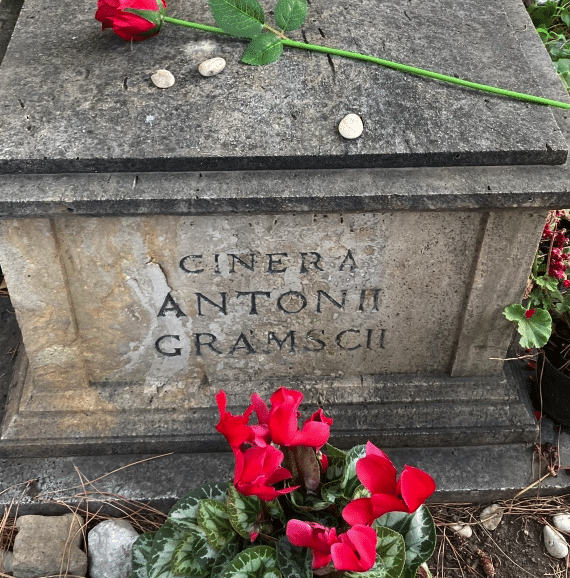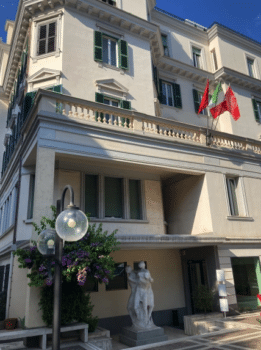 A few weeks ago, I was standing under the entrance arch of the Hotel Villa Morgagni along via Giovanni Battista Morgagni, in Rome’s northeastern Nomentano neighborhood. It’s a smart looking mansion-cum-townhouse, built in a turn-of-the-century Liberty style, with some fetching Art Nouveau flourishes. Since the early 2000s, the property has been owned by the Italian businessman Adartico Vudafieri, a former rally car champion, who’d transformed it into a 4-star, 34-room, luxury boutique hotel, equipped with jacuzzis and conference room facilities.
A few weeks ago, I was standing under the entrance arch of the Hotel Villa Morgagni along via Giovanni Battista Morgagni, in Rome’s northeastern Nomentano neighborhood. It’s a smart looking mansion-cum-townhouse, built in a turn-of-the-century Liberty style, with some fetching Art Nouveau flourishes. Since the early 2000s, the property has been owned by the Italian businessman Adartico Vudafieri, a former rally car champion, who’d transformed it into a 4-star, 34-room, luxury boutique hotel, equipped with jacuzzis and conference room facilities.
Ninety-seven years back, via Giovanni Battista Morgagni, number 25, was a more modest lodging house, home of a quietly discreet pensionante called Antonio Gramsci. It was here, around 10:30pm on November 8, 1926, that Mussolini’s fascist henchmen, who’d been surveying Gramsci’s every move in the months prior, raided his room, confiscated his documents, and arrested him as an “enemy of the state.” (It wasn’t the first time his room had been ransacked.) He was carted off to Rome’s Regina Coeli penitentiary and immediately placed in solitary confinement. A small plaque on the hotel’s gatepost, with a poignant inscription, commemorates Gramsci’s sojourn at Morgagni, memorializing him as a rare “leader who knew how to listen”:
Gramsci’s landlady, Clara Passarge, a Prussian-born woman, was particularly disgruntled by those evening’s dramatic events, taking it very badly. Gramsci was her and husband Giorgio’s favorite tenant—the “professor” they affectionately called him, on account of his bookish nature, a scholarly-looking little man forever transporting caseloads of texts and papers to and from his rented room. (The professorial assumption wouldn’t have been unreasonable: Sapienza University of Rome was, after all, only a block away down the road from his dwelling.) Gramsci, of course, was no university academic. Journalist, Italian Communist Party’s (PCI) general secretary, he’d already been elected to Italy’s Chamber of Deputies, a position that should have given him immunity from such a politically motivated arrest. But Mussolini had schemed up Special Laws of Defense, rendering illegal any form of anti-fascist activity, depriving Gramsci and hundreds of other progressive deputies of their parliamentary mandate.
 For a customarily cautious man, whose careful analysis had seen fascist forces brewing, it was a mystery why Gramsci had left himself so open to arrest. He knew he was being followed, watched everywhere and at all hours; he’d felt “the storm coming,” he told sister-in-law Tatiana (“Tania”), “in an indistinct and instinctive way.” Meanwhile, fearing for the safety of pregnant wife Giulia and infant son Delio, he insisted they return to Moscow, where Gramsci’s second son, Giuliano, who would never see his father, was born on August 30, 1926.
For a customarily cautious man, whose careful analysis had seen fascist forces brewing, it was a mystery why Gramsci had left himself so open to arrest. He knew he was being followed, watched everywhere and at all hours; he’d felt “the storm coming,” he told sister-in-law Tatiana (“Tania”), “in an indistinct and instinctive way.” Meanwhile, fearing for the safety of pregnant wife Giulia and infant son Delio, he insisted they return to Moscow, where Gramsci’s second son, Giuliano, who would never see his father, was born on August 30, 1926.
In a way, Gramsci seemed more bothered about the “trouble and inconveniences” he’d caused the Passarges the night of his arrest. The first of his famous Letters from Prison, written in the Regina Coeli penitentiary (undated), addressed to his landlady, is a touching expression of regret: “Dearest Signora, first of all, I want to apologize for the trouble and inconveniences I have caused you, which in truth formed no part of our tenancy agreement.” Gramsci asks her to forward onto him a few of his books, including his beloved Divine Comedy, and “prepare some of my underclothes and hand them over to a good woman called Marietta Bucciarelli, when she comes on my behalf.” “If my stay in this place,” Gramsci adds, “should last long, I think you should consider the room free and do as you wish with it. You can pack the books and throw away the newspapers. I apologize again, dear signora, and offer my regrets which are as deep as your kindness is great. My regards to signor Giorgio and to the young lady [Clara’s daughter]; with heartfelt respect, Antonio Gramsci.” The letter is all the more touching because it never reached its destination.
A few weeks on, Gramsci again wrote his landlady (November 30, 1926), telling her he’d been three days in a Palermo jail. “I left Rome on the morning of the twenty-fifth,” Gramsci said, “for Naples, where I stayed for a few days and was devoured by insects. In a few days, I will leave for the island of Ustica, to which I have been assigned for my confino. During my journey, I was unable to send back the keys to the house: as soon as I arrive at Ustica I will forward them immediately and I’ll send you the precise address and instructions for sending me or having sent to me the things that I’ll be able to keep here and that may be useful to me. My health is fairly good; I’m a bit tired, that’s all. Inform Maria if she comes to see you and ask her to give my regards to all my relatives and friends who still remember me. Kind regards to signor Giorgio and to the signorina, cordially, A. Gramsci.” Again, the letter never found its destination, again confiscated by Mussolini’s political police. (Both letters, incidentally, never saw the public light of day until the early 1970s.)
 As it happened, signora Clara didn’t last long after Gramsci’s arrest; likely he’d suspected all wasn’t well. He’d asked Tania (March 19, 1927), “How is my landlady, or did she die?” “I’m afraid the scene of my arrest may have helped accelerate her illness,” he confessed, “because she liked me very much and looked so pale when they took me away.” Gramsci said he’d received a letter from Giorgio Passarge in early January 1927, “who was desperate and thought that his wife’s death was immanent, then I no longer heard anything. Poor woman.” Signora Passarge would pass away on February 19, 1927, aged sixty-five.
As it happened, signora Clara didn’t last long after Gramsci’s arrest; likely he’d suspected all wasn’t well. He’d asked Tania (March 19, 1927), “How is my landlady, or did she die?” “I’m afraid the scene of my arrest may have helped accelerate her illness,” he confessed, “because she liked me very much and looked so pale when they took me away.” Gramsci said he’d received a letter from Giorgio Passarge in early January 1927, “who was desperate and thought that his wife’s death was immanent, then I no longer heard anything. Poor woman.” Signora Passarge would pass away on February 19, 1927, aged sixty-five.
Not long after my visit to Gramsci’s old lodgings and site of arrest, I discovered something I’d hitherto not known: Clara Passarge is likewise a denizen of Rome’s Non-Catholic Cemetery. I’d spotted her gravestone, looking rather forlorn and untended, on one of my regular inspections of the tombs and their environs. Seeing Gramsci and his former landlady reunited, sharing the same abode again, struck me as a strange quirk of fate, just as my witnessing it strikes me as a strange quirk of fate, finding myself before both of them now, a volunteer at the cemetery.
Clara’s grave prompted me to look her up in the cemetery’s death register, where I managed to track down the original, handwritten entry. Then I did the same for Gramsci, wondering why I hadn’t done so before; sure enough, he’s there, too, registered in the same hand a little more than a decade after the “signora’s” passing.
To say that Clara’s grave looked forlorn and untended isn’t exactly the whole truth. For there’s another story to her being at the cemetery, another connection involving an impressive, far from forlorn, white marble sculpture located just behind Clara’s tombstone, tucked into an alcove of the Aurelian wall. It’s a striking, haunting, structure known as “The Bride,” a life-size (and life-like) reclining young woman, on her deathbed; a rose is sometimes placed in her hand, a gesture said to bring good luck to the giver. The bride in question is Elsbeth Wegener Passarge, none other than Clara Passarge’s eldest daughter, who died in 1902, tragically of typhus, at the age of age 18. She was born in Prussia to Clara’s first husband (Giorgio was Elsbeth’s stepfather), yet grew up in Rome, later engaged to be married to an Austrian sculptor Ferdinand Seeboeck. The couple were deeply in love. But the husband-and-wife pairing wasn’t meant to be, and as a memorial to his late fiancée, Ferdinand created “The Bride,” with, on its base, written in Italian and German, the following words: “She passes from a sweet dream of love to the life of angels.” It took Ferdinand thirty-years to get his sculpture installed in its current site, during which time he’d relinquished his own plot beside his bride, in favor of her mother, Clara, whose remains now lie beside her daughter’s, and not in the marked grave nearby.
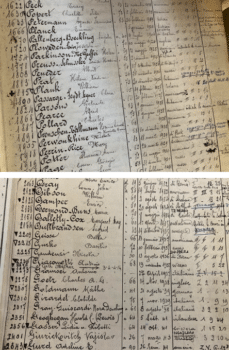 The day I discovered Clara’s tombstone, Gramsci’s marble casket was adorned with a beautiful red rose. At that moment, sitting close by on what I now like to call “Gramsci’s bench,” was an elderly gent, in his mid-seventies, portly with long, flowing gray hair, clad in scruffy shorts and a stained white undervest. Beside him a shopping bag full of old clothes. Maybe he was homeless or semi-destitute? He looked content next to Gramsci, and, as I passed, taking a photo of the red rose on the casket, I engaged him in conversation. He was an old communist, he said, and Gramsci his hero. He comes here often, to pay his respects. Was it he, I wondered, who’d laid that red rose?
The day I discovered Clara’s tombstone, Gramsci’s marble casket was adorned with a beautiful red rose. At that moment, sitting close by on what I now like to call “Gramsci’s bench,” was an elderly gent, in his mid-seventies, portly with long, flowing gray hair, clad in scruffy shorts and a stained white undervest. Beside him a shopping bag full of old clothes. Maybe he was homeless or semi-destitute? He looked content next to Gramsci, and, as I passed, taking a photo of the red rose on the casket, I engaged him in conversation. He was an old communist, he said, and Gramsci his hero. He comes here often, to pay his respects. Was it he, I wondered, who’d laid that red rose?
For a while, we spoke about Giorgio Napolitano, a former high-ranking PCI leader, modern Italy’s longest standing President, who died in late September, aged 98, and who’s about to be laid to rest in the Non-Catholic Cemetery. The man in the white vest said Gramsci was better known abroad than in Italy; I was inclined to concur, but knew, too, that plenty of Italians, many young Italians included, visit the cemetery to see Gramsci, and talk about him as if he were still alive and kicking. Then the man in the white vest mentioned Benedetto Croce and Giovanni Gentile, two of Gramsci’s interlocutors and antagonists. I said, as a by-the-way comment, that Antonio Labriola, an older generation Italian Marxist, another early influence from Gramsci’s Turin student days, frequently referenced in The Prison Notebooks, is buried not far away, in an impressive, opulent looking grave in the Zona Prima. The man in the white vest seemed to want to talk more about Gentile and Croce and about Gramsci’s views on education.
Croce’s was a liberal, Gentile a fascist. Both started out as vaguely marxisant Hegelian philosophers, before the former drifted toward the center and the latter toward the far-right. Each wrote about education; in the early 1920s, Gentile became Mussolini’s Minister of Education. But Gramsci rejected, on the one side, Croce’s liberal reductionism, which saw civil society as the realm of free individuality, somehow apart from the state, and, on the other, Gentile’s statist reductionism, where civil society got devoured entirely by the state. Gramsci’s line is more subtle. He never makes any “organic” distinction between state and civil society. The separation, he said, is analytical and methodological; state and civil society are conjoined, dialectically intertwined, operative together, yet theoretically distinguishable.
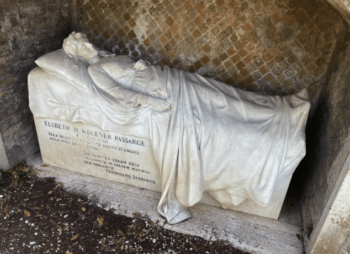 From prison, Gramsci cast a keen critical eye on the so-called Gentile Reform Act of 1923, where, amongst other things, religious education had become compulsory in elementary schools. Letters from Prison frequently ask Tania for copies of Gentile’s texts and speeches, a lot featured in a rather ominous sounding Educazione Fascista. Gentile’s educational reform also introduced an entrance exam for acceptance into middle-school, which, says Gramsci, privileged upper-class kids, relegating their working class and peasant counterparts to technical and training schools.
From prison, Gramsci cast a keen critical eye on the so-called Gentile Reform Act of 1923, where, amongst other things, religious education had become compulsory in elementary schools. Letters from Prison frequently ask Tania for copies of Gentile’s texts and speeches, a lot featured in a rather ominous sounding Educazione Fascista. Gentile’s educational reform also introduced an entrance exam for acceptance into middle-school, which, says Gramsci, privileged upper-class kids, relegating their working class and peasant counterparts to technical and training schools.
Gramsci was a bit old school in his educational beliefs. He says Gentile’s education act failed to provide the specific teaching of Italian grammar, thereby excluding “the national-popular masses from learning language, confining them to the ghetto of dialect.” (Gramsci advocates the teaching of Latin, for instance, because it “combines and satisfies a whole series of pedagogic and psychological requirements.”) “Active” schools, he says, aren’t elitist institutions nor sites of rote and factual inculcation. Yet neither should they encourage liberal laissez-faire free-play and voluntarist free-will, where individualities are seen as beyond any conditioning social relations and social institutions. Gramsci calls for a “nexus between instruction and education,” a curriculum that teaches critical, socially aware thinking at the same time as develops students’ creative capacities, accustoming them to reason, to think abstractly and schematically, while “remaining able to plunge back from abstraction into real and immediate life.”
For Gramsci, self-discipline and self-control are vital in learning. Students need to condition themselves to long hours of concentration, he says, to sitting still, developing bodily endurance as well as a lively mind, training their muscles and nerves as well as their brains. Learning can be tough, he says, an ethos likely gleaned from his own history as a lowly youth and studious prison inmate. It isn’t only manual labor, he says, that requires sweat and toil. Indeed, if ever the working classes were to develop their own brand of hardy and smart “organic intellectuals,” with the appropriate attributes and skills to help transform society, they’ll need, Gramsci thinks, an educational system very different from the one Gentile is proposing.
***
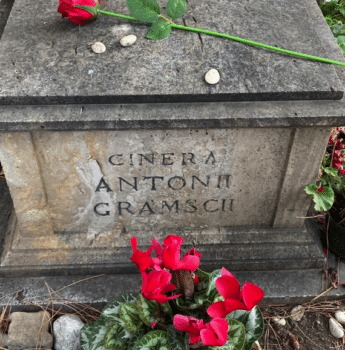 The man in the white vest and I shuck hands and we bid each other arrivederci. Wandering back to my duties at the cemetery’s Visitor’s Center, leaving him with Gramsci and that red rose, I realized I’d forgotten to ask if it was him who’d laid the flower there. I never got the chance to talk with him, either, about the significance of roses for Gramsci and how growing them became almost as much a passion as filling his thirty-three scholastic notebooks.
The man in the white vest and I shuck hands and we bid each other arrivederci. Wandering back to my duties at the cemetery’s Visitor’s Center, leaving him with Gramsci and that red rose, I realized I’d forgotten to ask if it was him who’d laid the flower there. I never got the chance to talk with him, either, about the significance of roses for Gramsci and how growing them became almost as much a passion as filling his thirty-three scholastic notebooks.
After Gramsci was transferred in July 1928 to the Turi prison for the infirm and disabled in Bari, Calabria, along a sidewall of its courtyard, in a little plot of soil, he began to grow different plants and flowers. His letters to Tania and Giulia thereafter begin to fill up with news of their progress. On April 22, 1929, he wrote Tania: “On one fourth of a square meter I want to plant four or five seeds of each kind and see how they turn out.” He asks his sister-in-law if she can get hold of sweet pea, spinach, carrot, chicory, and celery seeds.
Gramsci says he’s become more patient, “but only by virtue of a great effort to control myself.” He seems to take inspiration from his flowers and plants, from their slow and persistent growth, from the rose he’s trying to cultivate, patiently and persistently—against all odds. “The rose has fallen victim of a dreadful sunstroke,” he says, “all the leaves in the more tender parts are burnt and carbonized; it has a desolate, sad aspect, but it is putting out new buds.” Seemingly referring to himself, he adds: “It isn’t dead, at least not yet.” In Gramsci’s letters, the plight of his dear rose strikes as an allegory of his own dear plight.
“The seeds have been very slow in pushing up small sprouts,” he tells Tania, again maybe referring to himself and to the life of a Marxist radical; “an entire series obstinately insists on living an underground life.” Each day, Gramsci says, he’s seized by the temptation to pull at them a little, making them grow a little faster. “I remain undecided,” he admits,
between two concepts of the world and of education: whether to follow Rousseau and leave things to nature, which is never wrong and is basically good, or to be a voluntarist and force nature, introducing into the evolution the expert hand of humanity and the principle of authority. Until now the uncertainty persists and the two ideologies joust in my head.
Still, Gramsci’s voluntarist environmentalism—the intervention of human authority and action—doesn’t brutally impose itself on nature. He lovingly cares for his rose, admires its beauty and tenderness, the delicate texturing of its petals, its poetic quality, the radiance of its blossoming, often sounding the way Saint-Exupery’s petit prince would sound a decade on, nurturing his own rose; at the same time, Gramsci marvels at how robust his rose is, how hardy, struggling to survive, persisting on living, sometimes on the point of death, yet pulling through with new buds despite the impending “solar catastrophe.”
Elsewhere, Gramsci says to Tania: “The rose is beginning to bud after it had seemed reduced to desolate twigs. But will it manage to survive the approaching summer heat? It looks puny and run down to be up to the task. It is true of course that, at bottom, the rose is nothing but a wild thorn bush, and therefore very vital.” Again, maybe with himself in mind, we might recall one revealing letter he’d written Tania, earlier on in his incarceration (February 19, 1927), taking the boat with other prisoners to Ustica. One of the banished was an “anarchist type,” Gramsci says, called “Unico,” a sort of superintendent, who upon hearing Gramsci introduce himself to other inmates,
stared at me for a long time, then he asked: ‘Gramsci, Antonio?’ ‘Yes’, Antonio! I answered. ‘That can’t be’, he retorted, ‘because Antonio Gramsci must be a giant and not a little squirt like you’.
On February 10, 1930, Gramsci writes Tania:
So, then, become more energetic; cure your will too, do not let the southern winds fill you with languor. The bulbs have sprouted already, indeed some time back; one of the hyacinths already shows the colors of its future flower. Provided the frost doesn’t destroy everything. The rose has also borne new buds; it is wilder than ever, it seems a thorn bush instead of a rose, but the vegetal vigor of the thorn bush is also interesting. I embrace you affectionately. Antonio.
***
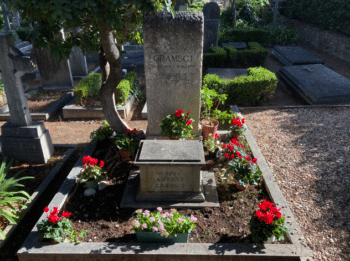 Today, October 17, 2023, Gramsci’s grave was covered with brilliant flowers, blooming everywhere, a sight to behold. Who could have placed them all here? Today, as well, I began to think about what it was I wanted to stress in this blog. If last time I spoke of stones and a sense of obligation—obligation to Gramsci, to Marxist politics, to the Left, a sentiment somehow reinforced by the little grapefruit-sized rocks a deformed Gramsci had lifted as a child—now, I think it’s the rose I want to emphasize, a rose for Gramsci, and the notion of resilience. Not just of our intervening to nurture nature, to sustain ourselves ecologically, but of an individual capacity for resilience, a stoicism to resist, to learn and educate oneself, to promulgate a politics of emancipation even in incarceration, even in an inferno resembling Dante’s.
Today, October 17, 2023, Gramsci’s grave was covered with brilliant flowers, blooming everywhere, a sight to behold. Who could have placed them all here? Today, as well, I began to think about what it was I wanted to stress in this blog. If last time I spoke of stones and a sense of obligation—obligation to Gramsci, to Marxist politics, to the Left, a sentiment somehow reinforced by the little grapefruit-sized rocks a deformed Gramsci had lifted as a child—now, I think it’s the rose I want to emphasize, a rose for Gramsci, and the notion of resilience. Not just of our intervening to nurture nature, to sustain ourselves ecologically, but of an individual capacity for resilience, a stoicism to resist, to learn and educate oneself, to promulgate a politics of emancipation even in incarceration, even in an inferno resembling Dante’s.
“It seems to me that under such conditions prolonged for years,” Gramsci told his younger brother Carlo (December 19, 1929),
and with such psychological experience, a person should have reached the loftiest stage of stoic serenity and should have acquired such a profound conviction that humans bear within themselves the source of their own moral strength, that everything depends on them, on their energy, on their will, on the iron coherence of the aims that they set for themselves and the means they adopt to realize them, that they will never again despair and lapse into those vulgar, banal states of mind that are called pessimism and optimism. My state of mind syntheses these two emotions and overcomes them: I’m a pessimist because of intelligence, but an optimist because of will.
Today, those Gramsci’s flowers remind me of Elsa Morante’s epic novel called History, on the horrors of Nazism/fascism, and the rape of a young woman by a adolescent German soldier (killed a few days later on the front) and her fierce battle to raise her bastard child in the horror of it all, in a world Gramsci often said was “vast and terrible,” and her hope that hope would win out in the end, and her final words, Morante’s final note, borrowing from a Gramsci letter, never mentioning him by name, only his Turi prison number…7047: “All the seeds have failed except one; I don’t know what it is, but probably it is a flower and not a weed.” That’s it, that’s what I want to say: flowers will always outlast weeds.

